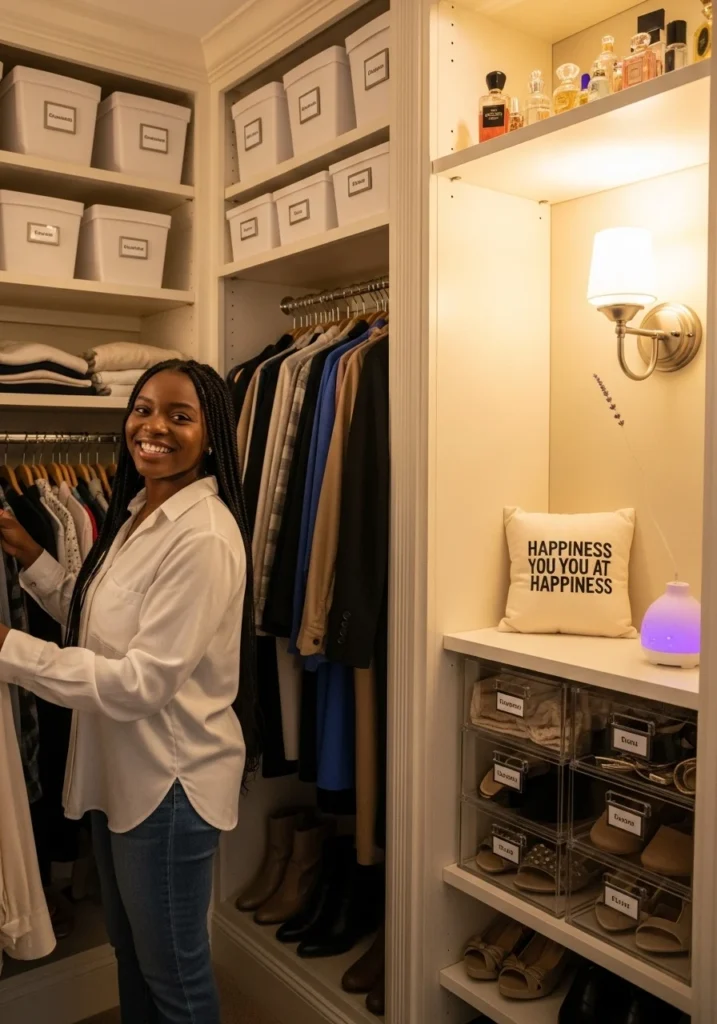Introduction
Let’s face it—an unorganized closet can quickly become a major source of daily frustration. You might be scrambling in the morning, trying to find your favorite shirt or the right pair of shoes, only to end up running late for work or school. Perhaps you’ve experienced that sinking feeling of opening your closet door and being greeted by a jumbled mess of clothes, hangers, and forgotten items shoved into corners. It’s more than just a visual nuisance—it’s a time-waster, an energy drain, and in many cases, a contributing factor to daily stress.
Closet clutter doesn’t just affect your physical space; it influences your mindset too. Studies have shown that visual chaos can negatively impact mental clarity, making it harder to focus and feel in control. On the flip side, a well-organized closet brings structure, saves time, and can even improve your mood by creating a sense of calm and satisfaction each time you open the door.
The good news? You don’t need a walk-in wardrobe, custom carpentry, or a big budget to transform your closet into a functional, beautiful space. With smart strategies, a little creativity, and practical tools, anyone can maximize their closet—regardless of size or storage constraints.
In this guide, we’ll walk you through the most effective and easy-to-implement closet organization ideas that work for any lifestyle. From decluttering and space-saving techniques to storage hacks and styling tips, you’ll learn how to take full control of your wardrobe—turning it from a daily hassle into a streamlined, stress-free zone.
Whether you’re tackling a small apartment closet or revamping a spacious walk-in, these tried-and-true solutions will help you make the most of your space and simplify your everyday routine. Let’s dive in and take the first step toward a cleaner, more organized, and more enjoyable home environment.
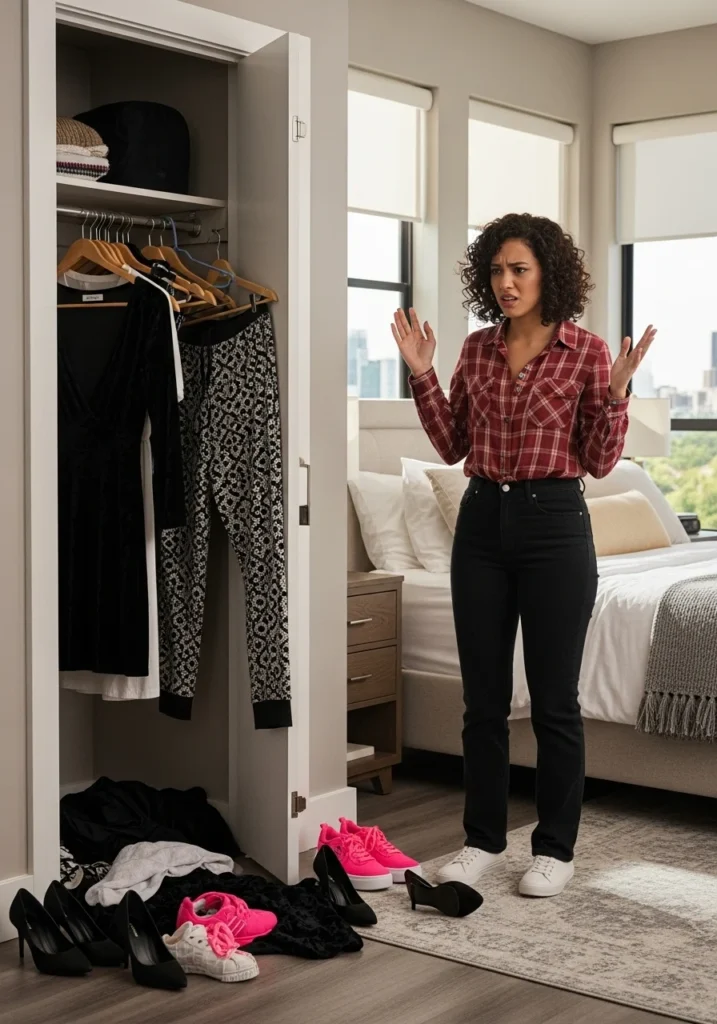
Why Closet Organization Matters
When most people think about organizing their closet, they often view it as a purely aesthetic project. But the benefits of a well-organized closet go far beyond simply making things look nice. In fact, the way your wardrobe is arranged can directly affect your time, mood, and even the longevity of your clothes. Whether you’re managing a compact reach-in closet or a walk-in wardrobe, maintaining an organized system can dramatically improve your everyday life.
Here are five compelling reasons why closet organization is more important than you might think:
1. Saves Time: Eliminate the Daily Search
One of the most immediate benefits of a tidy closet is the time it saves you. When every item has a designated place, you no longer have to waste precious minutes digging through piles of clothes or mismatched shoes just to get ready in the morning. Imagine being able to find your favorite blouse or that perfect belt within seconds—no frustration, no last-minute outfit changes. With an organized system in place, your daily routine becomes smoother and faster, freeing up time for the things that truly matter.
2. Reduces Stress: Create a Calming Environment
Clutter is known to create mental noise. When your physical environment is chaotic, it can subtly influence your stress levels and even affect your mood. On the other hand, walking into a clean, orderly closet has a surprisingly calming effect. It signals control, peace, and balance—qualities that are essential in our often hectic lives. By streamlining your closet, you’re also creating a more peaceful morning routine, which can set the tone for a better, more productive day.
3. Increases Space: Maximize Every Inch
You don’t need a massive walk-in closet to store your clothing effectively. Through smart organization techniques like vertical storage, shelf dividers, and multi-functional hangers, even the tiniest closets can be transformed to feel spacious and functional. It’s all about working with what you have and using it wisely. With the right layout and storage solutions, you’ll be amazed at how much space you actually have—often uncovering hidden areas you weren’t utilizing at all.
4. Protects Your Clothes: Extend Their Lifespan
Tangled hangers, crumpled clothing, and clothes piled on the floor can cause wear and tear on your wardrobe. Delicate fabrics may snag, wrinkle, or lose their shape when not stored properly. An organized closet allows you to hang, fold, and store each item according to its specific needs, which helps preserve fabric quality and extend the life of your garments. In the long run, this also saves money, as you won’t need to replace worn-out items as frequently.
5. Improves Daily Functionality: Make the Most of What You Own
How many times have you rediscovered a piece of clothing you forgot you had—buried behind clutter or tucked away in an overstuffed drawer? When your closet is organized, you can actually see what you own and put more of your wardrobe into regular rotation. This leads to smarter outfit choices, better style variety, and fewer impulse purchases. In short, closet organization helps you shop your own closet more efficiently, encouraging mindful fashion habits.
Final Thoughts on Closet Importance
An organized closet isn’t just about aesthetics—it’s a cornerstone of a more balanced lifestyle. It supports your daily routine, enhances your peace of mind, and brings order to a part of your home that you interact with every single day. Whether your goal is to reduce stress, save time, or simply enjoy your wardrobe more, closet organization is an investment that pays off in countless ways.
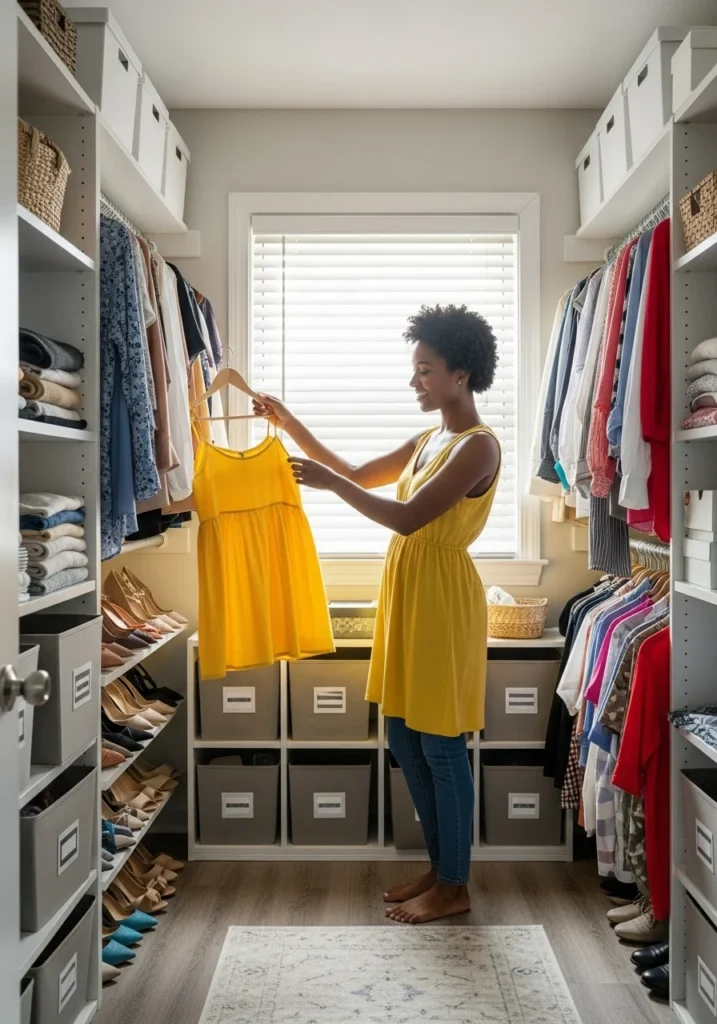
Types of Closets and Their Challenges
Before diving into closet organization strategies, it’s essential to understand the type of closet you’re working with. Different closet types come with their own set of strengths and limitations. Knowing the unique characteristics of your closet allows you to select the right tools, storage systems, and organization methods that will deliver the best results.
Here’s a breakdown of the most common types of closets—and the typical challenges they present—along with helpful hints on how to overcome them.
Walk-In Closets: Spacious but Easily Overwhelmed
Walk-in closets are often seen as the gold standard of wardrobe storage. With ample room for hanging, shelving, and even floor space, they offer the flexibility to store clothes, shoes, accessories, and more. Many people even use walk-in closets as mini dressing rooms or vanity spaces.
Common Challenges:
- Overcrowding: Large spaces often lead to a “just keep adding” mentality, which can result in clutter and disorganization.
- Lack of Zoning: Without clearly defined areas for different items (e.g., workwear, casuals, accessories), things can get mixed up quickly.
- Wasted Space: High ceilings and deep corners often go underutilized if not planned properly.
Organization Tips:
- Use zoning techniques by dividing your closet into categories (shirts, dresses, bags, etc.).
- Install adjustable shelving, drawer units, and corner organizers to make the most of unused space.
- Add lighting to enhance visibility and ambiance.
Reach-In Closets: Compact and Common, But Challenging
Reach-in closets are found in most apartments, condos, and smaller homes. They’re usually enclosed behind sliding or bi-fold doors and can be anywhere from three to eight feet wide. While functional, they often lack depth and can feel cramped.
Common Challenges:
- Limited hanging space: A single rod may not be enough for all your clothes.
- Poor visibility: Items get pushed to the sides or hidden behind others.
- Awkward corners: Hard to access and easy to clutter.
Organization Tips:
- Add a second clothing rod to double your hanging capacity.
- Use vertical space with hanging organizers, tall shelves, and over-the-door hooks.
- Invest in slim, non-slip hangers to reduce bulk and create a uniform look.
- Consider installing sliding drawers or pull-out bins for smaller accessories.
Small or No Closet Spaces: Get Creative with Storage
Not everyone has the luxury of a built-in closet. In older homes or minimalist apartments, bedrooms may have very little—or no—closet space at all. In these cases, smart storage becomes essential.
Common Challenges:
- Lack of built-in structure: No rods, shelves, or designated storage areas.
- Visible clutter: Freestanding solutions can make the room feel messy if not well-curated.
- Limited square footage: Every inch counts, especially in small living spaces.
Organization Tips:
- Use freestanding wardrobes or armoires to mimic closet functionality.
- Add open garment racks for a modern boutique-style display (great for small bedrooms or studio apartments).
- Use under-bed storage bins, stackable boxes, or rolling carts for seasonal or lesser-used items.
- Maximize corners and wall space with floating shelves, wall hooks, or hanging organizers.
Final Thoughts on Closet Types
Understanding your closet type is the foundation of successful organization. Whether you’re blessed with a spacious walk-in or working with a modest reach-in—or even improvising with no closet at all—there are smart, practical solutions for every scenario. The key is to be realistic about your space, embrace creative thinking, and choose systems that align with your daily habits and storage needs.
Before you begin organizing, take a moment to assess what kind of closet you’re working with. This simple step will help guide your entire organization process—and set you up for lasting success.
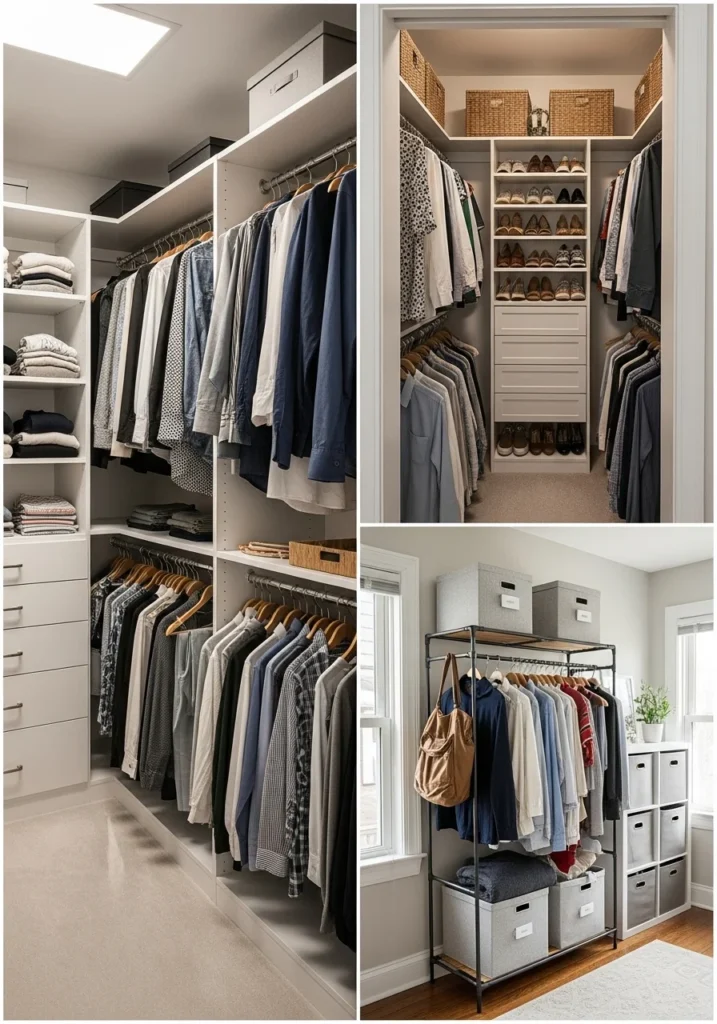
Closet Organization Essentials
Before you dive into color-coding or Pinterest-worthy closet makeovers, it’s important to start with the right tools. Closet organization isn’t just about tidying up—it’s about creating a system that’s easy to maintain, makes your life more efficient, and brings a sense of calm to your daily routine. Whether you’re organizing a walk-in closet, a reach-in space, or a freestanding wardrobe setup, having the right essentials on hand makes the entire process smoother and more effective.
Here are the must-have items every well-organized closet needs, along with tips on how to use them to their full potential:
1. Hangers: The Foundation of Closet Order
Not all hangers are created equal. Upgrading your hanger game can instantly make your closet look neater and help protect your clothing.
Recommended Types:
- Slimline Hangers: These are space-saving and often covered with velvet to keep garments from slipping off.
- Wooden Hangers: Sturdy and ideal for heavier items like coats, suits, or blazers.
- Padded Hangers: Great for delicate fabrics like silk or lace, which need gentle support.
Pro Tip: Stick to one type of hanger for a uniform look—it instantly elevates the appearance of your closet and helps streamline the space visually.
2. Drawer Dividers: Keep Small Items Tidy
Drawers can quickly become black holes where socks, underwear, ties, and accessories disappear into chaos. Drawer dividers help separate and categorize these items, making them easier to find and put away.
Use them to:
- Create sections for lingerie, socks, and undergarments.
- Organize belts, scarves, and small accessories.
- Keep folded items neat and uniform.
Adjustable or fabric dividers work well and can be customized based on drawer size.
3. Storage Bins and Baskets: Contain the Clutter
Bins and baskets are lifesavers when it comes to grouping similar items or storing things that don’t hang well. They’re also great for seasonal clothes or items you don’t need every day.
Ideal Uses:
- Store sweaters, gym wear, or handbags.
- Organize accessories like hats, gloves, and scarves.
- Keep off-season items out of the way but still accessible.
Opt for clear bins so you can see what’s inside, or choose labeled woven baskets for a more decorative, uniform look.
4. Over-the-Door Organizers: Maximize Hidden Space
Don’t forget about the back of your closet or bedroom door—it’s valuable real estate! Over-the-door organizers come in many styles, including fabric pockets, hooks, and even mini shelving units.
Best For:
- Shoes, especially flats and sandals.
- Scarves, belts, and small bags.
- Beauty products or daily-use accessories.
They’re especially helpful in small closets or rental spaces where permanent fixtures aren’t an option.
5. Hooks and Hanging Racks: Versatile and Easy to Install
When space is tight, wall hooks and hanging racks become your best friends. These tools help utilize vertical and corner space that often goes unused.
Common Uses:
- Hanging purses, hats, or jewelry.
- Holding tomorrow’s outfit (perfect for planning ahead).
- Hanging backpacks, robes, or reusable shopping bags.
Look for adhesive hooks for damage-free solutions or opt for stylish wall-mounted options to match your décor.
6. Shoe Racks or Stackable Shelves: Tame the Footwear Frenzy
Shoes are one of the biggest contributors to closet clutter. A dedicated shoe rack or stackable shelf system ensures your footwear stays off the floor and in sight.
Organize by:
- Type (heels, sneakers, sandals).
- Frequency of use (everyday vs. special occasions).
- Season (swap out summer/winter styles as needed).
Clear boxes or drop-front shoe organizers are also a great option for a cleaner, uniform look.
7. Labels or a Label Maker: The Finishing Touch
Once everything is in its place, labels help maintain the system. Labeling bins, baskets, and drawers ensures everyone in your home knows what goes where—reducing mess and saving time.
Use labels for:
- Categories (e.g., “Workout Clothes,” “Winter Scarves,” “Swimwear”).
- Names (if sharing a closet or family storage).
- Specific items (especially in deep bins where visibility is limited).
You can use chalkboard tags, adhesive labels, or a label maker for a clean, professional finish.
Final Thoughts on Closet Essentials
Having the right tools makes all the difference when organizing your closet. These essentials not only help you declutter and tidy up but also build the framework for a system that works with your lifestyle. The goal is not perfection—but functionality, simplicity, and peace of mind.
Before you start your organizing journey, gather these tools and set yourself up for long-term success. With a well-equipped toolkit, you’ll be amazed at how easily your space can transform from chaotic to curated.
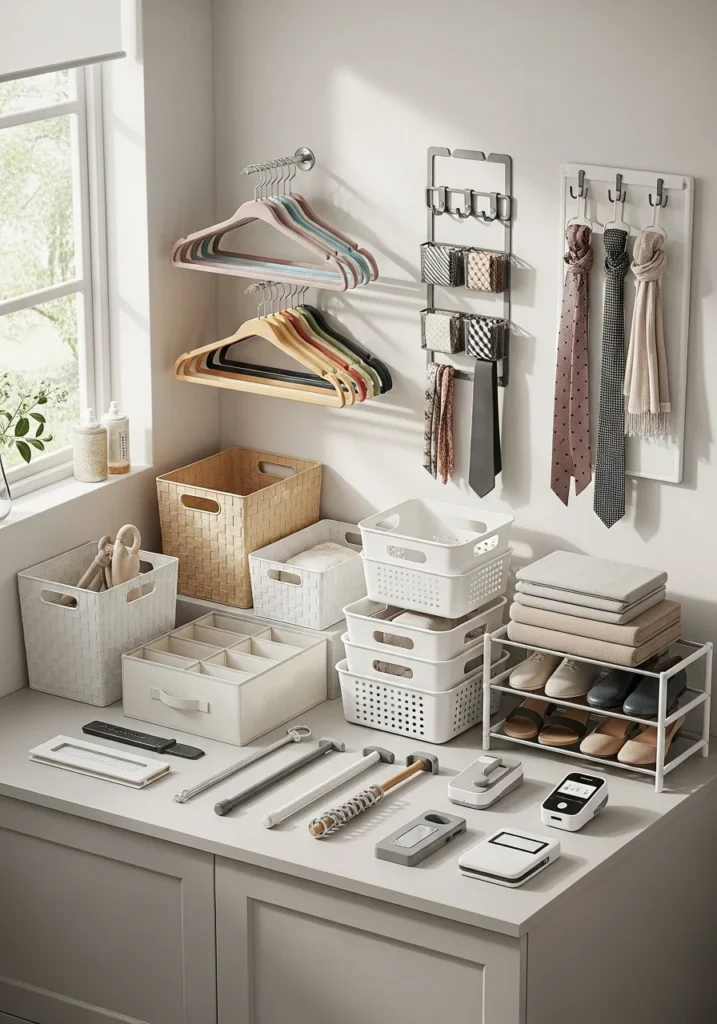
25 Genius Closet Organization Ideas
Closet organization is more than folding shirts and hanging jackets—it’s about creating a space that serves your lifestyle, saves time, and brings peace to your daily routine. Whether you’re dealing with a cramped apartment closet or a spacious walk-in, these 25 genius organization ideas will help you reclaim order, maximize space, and make getting dressed a pleasure, not a chore.
Let’s dive into the most practical, creative, and effective closet organization hacks:
1. Declutter Ruthlessly
Start with a clean slate. Go through every item in your closet and ask yourself: Have I worn this in the last year? If the answer is no, it’s time to let it go. Use the “1-year rule” as a guide—donate, sell, or recycle items you no longer need. This step creates space and ensures that only items you truly use and love remain.
2. Categorize by Type
Organizing by category—shirts, pants, dresses, jackets—helps you find items quickly and keeps your closet visually orderly. It also helps you take inventory of how much you own in each category, making future shopping smarter.
3. Use Matching Hangers
Uniform hangers bring harmony to your wardrobe. Velvet slimline hangers are perfect for small spaces because they take up less room and prevent clothes from slipping off. Wood hangers add a polished touch and are ideal for heavier garments like coats and suits.
4. Double Up Hanging Rods
Make the most of vertical space by adding a second hanging rod. This effectively doubles your hanging area and is ideal for organizing shorter items like shirts, blouses, and pants. It’s especially useful in reach-in closets with limited square footage.
5. Color Code Your Wardrobe
Sorting your clothes by color is both functional and visually appealing. It allows you to find what you need faster and makes outfit coordination easier. Start with light colors and gradually transition to darks for a natural flow.
6. Install Pull-Out Drawers
If your closet lacks drawer space, consider adding pull-out wire or wooden drawers. They’re perfect for organizing folded items, undergarments, or accessories like belts and scarves. Sliding drawers also help maintain visibility and avoid messy piles.
7. Incorporate Shelf Dividers
Use shelf dividers to keep stacks of sweaters, jeans, or linens neatly separated. They prevent toppling and make each category feel contained and easy to access.
8. Use Hanging Shelf Organizers
Fabric hanging organizers are great for closets without built-in shelves. Use them for bulky items like jeans, sweatshirts, or handbags. Many have compartments for shoes or accessories, maximizing vertical space.
9. Add Clear Storage Boxes
Store out-of-season clothing, shoes, or specialty items in clear plastic boxes. Being able to see what’s inside saves time and reduces rummaging. Label each box for extra organization.
10. Turn Doors into Storage Stations
The back of your closet door is often unused gold. Install over-the-door racks or pocket organizers to store shoes, jewelry, scarves, or toiletries—especially useful in shared or small living spaces.
11. Label Everything
Labels are the secret weapon of a long-lasting organization system. Use labels on bins, drawers, shelves, and boxes to keep things in their designated place. Invest in a label maker for a clean, professional look.
12. Store Shoes Vertically
Instead of lining shoes across the floor, use vertical racks, shoe cubbies, or stackable shelves. Wall-mounted shoe holders are also great for saving space and keeping footwear in good condition.
13. Optimize Corners
Closet corners often go underused. Add curved rods, corner shelves, or even a Lazy Susan-style rotating unit to utilize every inch. This is particularly effective in walk-in closets or irregular layouts.
14. Use Hanging Hooks or Pegs
Install hooks or pegboards on closet walls or doors to hang items like belts, hats, handbags, or jewelry. These small tools can dramatically improve access and keep delicate items untangled.
15. Add a Mirror
A full-length mirror inside or near your closet makes outfit selection easier. It also creates the illusion of a larger, more open space. Mirrors with built-in storage or lighting can add even more function.
16. Incorporate Lighting
Closets often lack adequate lighting. Add battery-powered LED lights, motion-sensor pucks, or LED strip lights to brighten shelves, corners, and dark zones. Better visibility means better choices and less clutter.
17. Store Seasonal Clothes Separately
To avoid overcrowding, rotate your wardrobe by season. Use under-bed bins, vacuum-seal bags, or top-shelf storage to pack away out-of-season items. This ensures your closet holds only what you need right now.
18. Keep a Donation Bin
Always keep a small bin or basket inside your closet designated for items you no longer want. This encourages regular editing and makes donation or resale more manageable over time.
19. Use Rolling Carts
In shared closets or open wardrobe setups, rolling carts offer mobile and versatile storage. Use them for shoes, bags, accessories, or even laundry supplies. They can also be rolled out for cleaning or rearranging.
20. Try a Capsule Wardrobe
Simplify your closet by building a capsule wardrobe—a curated collection of versatile, mix-and-match pieces that reflect your style. This minimizes clutter and makes dressing easier and more intentional.
21. Use Labeled Drawer Dividers
Take drawer organization to the next level by using labeled dividers. They’re perfect for separating socks, ties, bras, and other small items. You’ll never have to dig through a messy drawer again.
22. Store Bags Upright
Handbags often get crushed or lost in clutter. Use shelf dividers, bookends, or vertical bins to store them upright and maintain their shape. Stuff them with tissue paper when not in use for added protection.
23. Add a Command Center
Install a mini command center inside your closet. A small whiteboard or clipboard can be used for tracking laundry days, writing outfit ideas, or planning packing lists. It adds functionality and helps you stay organized.
24. Create Zones
Divide your closet into specific zones—workwear, gym clothes, loungewear, special occasion, etc. This method helps you get dressed faster and keeps similar items grouped together.
25. Make it Personal
Finally, add touches that reflect your personality. Use decorative bins, framed photos, inspirational quotes, or scented sachets to make your closet feel like your own personal boutique. The more you love the space, the more likely you are to keep it organized.
Final Thoughts on Closet Organization Ideas
A well-organized closet is not just a storage space—it’s a foundation for a smoother, more efficient lifestyle. These 25 genius ideas combine practicality and creativity to help you make the most of your space, no matter your closet’s size or layout. By implementing even a few of these tips, you’ll enjoy less stress, faster mornings, and a renewed love for your wardrobe.
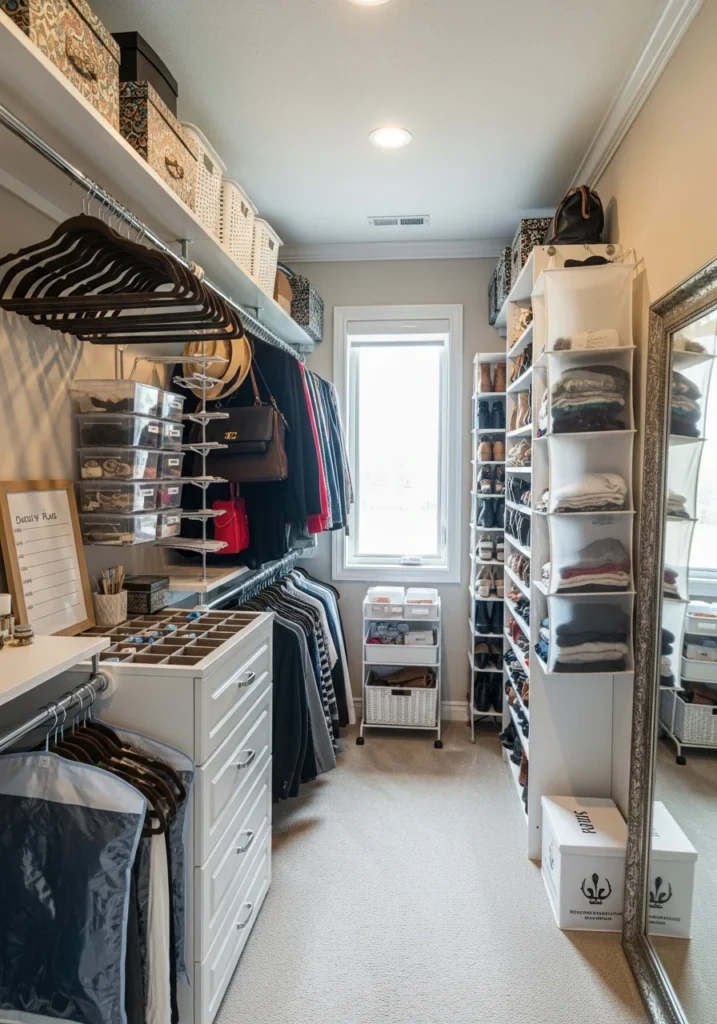
Seasonal Rotation Tips
One of the smartest habits for maintaining an organized closet is seasonal wardrobe rotation. This simple yet effective strategy keeps your closet clutter-free, improves accessibility, and ensures you’re always dressing appropriately for the current weather. Instead of overcrowding your space with clothes you won’t wear for months, seasonal rotation helps you stay organized and intentional with what you keep visible.
By rotating your wardrobe every 3 to 4 months, you create a streamlined system that makes outfit planning easier and gives your closet a fresh feel with every new season. Here’s how to do it efficiently:
1. Rotate Every 3 to 4 Months
Mark your calendar at the beginning of each new season—spring, summer, fall, and winter—to trigger your closet switch. This quarterly refresh is a great time to reassess your wardrobe, remove items you no longer wear, and prepare your space for seasonal changes.
Why it matters:
- Keeps your daily choices relevant to the weather.
- Prevents overcrowding by storing unused items.
- Helps you rediscover forgotten favorites before the next season arrives.
2. Store Off-Season Clothes in Labeled Bins
Once you’ve selected the items that are out of season, store them in clearly labeled bins or containers. Choose plastic storage bins with secure lids to keep out dust, moisture, and pests. Transparent bins make it easy to see what’s inside, while stackable containers help maximize space.
Smart storage locations:
- Under the bed
- High closet shelves
- Storage ottomans
- Attic or spare room (if temperature-controlled)
Label each bin by category and season—for example: “Winter Sweaters,” “Summer Dresses,” or “Cold Weather Accessories.” This will make the next rotation faster and easier.
3. Use Natural Moth-Repelling Sachets
Clothes stored for long periods are vulnerable to damage from moths and other pests, especially natural fabrics like wool, cashmere, and silk. Protect your garments by adding moth-repelling sachets to your storage containers.
Best options:
- Lavender: Naturally repels insects and leaves a pleasant scent.
- Cedar chips or blocks: A powerful moth deterrent that absorbs moisture.
- Clove and rosemary sachets: Another fragrant and effective alternative.
Avoid using chemical mothballs, which can leave unpleasant odors and may be harmful with prolonged exposure.
4. Evaluate Before You Store
Before packing items away, take a moment to assess whether each piece is worth storing. Ask yourself:
- Did I wear this at all during the last season?
- Does it still fit and flatter me?
- Is it in good condition, or does it need repair?
If the answer is no, consider donating, selling, or recycling the item instead of letting it take up precious storage space. Seasonal rotation is the perfect opportunity to edit your wardrobe and reduce clutter gradually.
5. Wash and Fold Properly
Always clean your clothes before putting them into storage. Dirt, sweat, and oils can attract pests and cause stains to set over time. Make sure everything is:
- Laundered or dry-cleaned
- Completely dry (to prevent mildew)
- Properly folded to avoid wrinkles
Use garment bags for delicate or formal items that need to hang during storage, and avoid packing damp or unwashed clothing to preserve freshness.
6. Refresh Your Closet for the New Season
As you bring in-season clothes back into your closet, take time to reorganize based on current needs. Hang the most frequently used items at eye level, place seasonal shoes within reach, and group accessories accordingly.
This is also a great time to wipe down shelves, vacuum the floor, and dust corners—keeping your closet fresh and clean before the new items go in.
Final Thoughts on Seasonal Rotation
Seasonal wardrobe rotation is more than a storage strategy—it’s a lifestyle habit that keeps your closet functional, your outfits weather-ready, and your mornings stress-free. By regularly evaluating, storing, and refreshing your wardrobe, you avoid unnecessary clutter and maintain a closet that truly works for you.
Whether you live in a climate with dramatic seasonal changes or just want to stay better organized, rotating your wardrobe every few months can make a noticeable difference. Start this simple habit today and enjoy a closet that feels new and purposeful all year long.
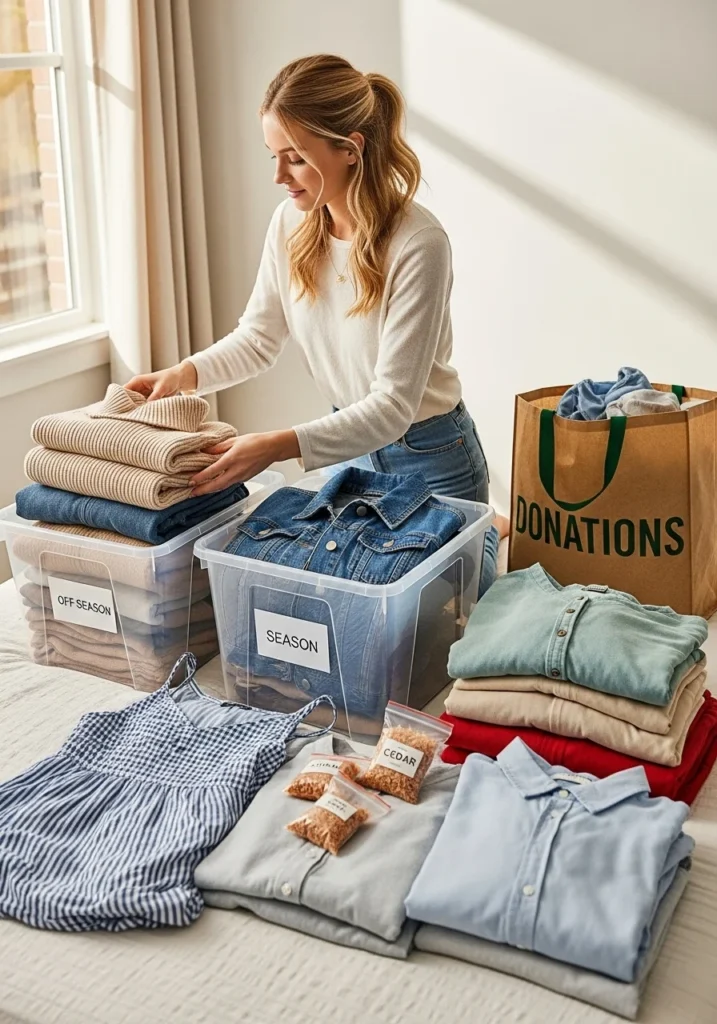
DIY vs. Professional Closet Systems
When it comes to organizing or revamping your closet, one of the biggest decisions you’ll face is whether to go the DIY route or invest in a professional closet system. Each option has its own set of advantages, and the best choice depends on your space, goals, budget, and how hands-on you want to be in the process.
Let’s break down the pros of both approaches so you can make an informed decision that aligns with your lifestyle and vision.
DIY Closet Systems: Affordable, Flexible, and Personalized
If you’re a fan of weekend projects or looking to save money, a DIY closet system might be your ideal solution. With the availability of ready-to-assemble components and creative storage tools, organizing your closet yourself is more accessible than ever.
DIY Pros:
1. Cost-Effective:
DIY solutions are usually more budget-friendly than professional installations. You can gradually purchase pieces over time and choose affordable materials that suit your financial comfort zone.
2. Customizable:
You’re in full control. Whether you need more hanging space, extra shoe shelves, or bins for accessories, you can design a layout that fits your specific needs without paying for features you don’t want.
3. Creative Freedom:
From paint colors and finishes to choosing bins, hooks, and labels, the DIY route gives you the freedom to express your personal style. You can also repurpose items like bookshelves, crates, or tension rods for creative storage hacks.
4. Immediate Results:
Many DIY closet systems from brands like IKEA, ClosetMaid, or The Container Store are easy to install with basic tools. You can complete your makeover in a weekend without having to wait for consultations or custom production.
Things to Consider:
- DIY systems require time, planning, and accurate measurements.
- Quality may vary depending on materials and installation skills.
- If you rent your home, make sure any modifications are removable or approved by your landlord.
Professional Closet Systems: Expert-Designed, Durable, and High-End
If you’re looking for a seamless, polished result and are willing to invest in long-term quality, a professional closet system might be the better choice. These systems are designed and installed by experts who tailor every detail to your space and needs.
Professional System Pros:
1. Efficient Use of Space:
Closet designers are trained to make the most of every square inch. They can identify underutilized areas and build custom solutions that maximize vertical space, corners, and unique layouts.
2. Custom Design Services:
Professional companies often offer in-home consultations and 3D renderings, so you can see exactly how your closet will look before installation. Every feature—down to the number of drawers, rods, and shelves—is tailored to your wardrobe and preferences.
3. Higher-End Finishes and Materials:
From solid wood cabinetry and soft-close drawers to luxury lighting and glass accents, professional systems provide a sleek, sophisticated look. These durable materials also tend to hold up better over time compared to DIY alternatives.
4. Added Home Value:
A professionally organized closet, especially a walk-in with built-ins, can increase your home’s resale value and appeal to potential buyers. It signals luxury, convenience, and attention to detail.
Things to Consider:
- Professional systems are significantly more expensive upfront.
- You may need to wait for appointments, design revisions, and installation timelines.
- Once installed, changes or modifications may be more difficult or costly.
How to Choose: DIY vs. Professional?
Here’s a simple guide to help you decide:
| Consideration | Go DIY If… | Choose Professional If… |
|---|---|---|
| Budget | You’re working with a limited budget | You’re ready to invest in long-term quality |
| Time | You want a weekend project | You prefer someone else to handle the details |
| Skill Level | You’re comfortable using tools and following plans | You want expert precision and a flawless finish |
| Design Control | You love customizing and experimenting | You want a refined, curated look |
| Space Size | You’re working with a small or simple layout | You have a walk-in or an awkward closet configuration |
Final Thoughts on Choosing the Right Closet System
Ultimately, the best organization system is the one that fits your needs, lifestyle, and budget. DIY closet makeovers are ideal for hands-on individuals who enjoy customizing their space and want to save money. On the other hand, professional closet systems offer unmatched elegance, efficiency, and durability—perfect for those who prefer a turn-key solution and long-term investment.
Whether you decide to go the DIY route or bring in the pros, what matters most is that your closet works for you. The goal is a functional, beautiful space that brings ease and joy to your daily life.
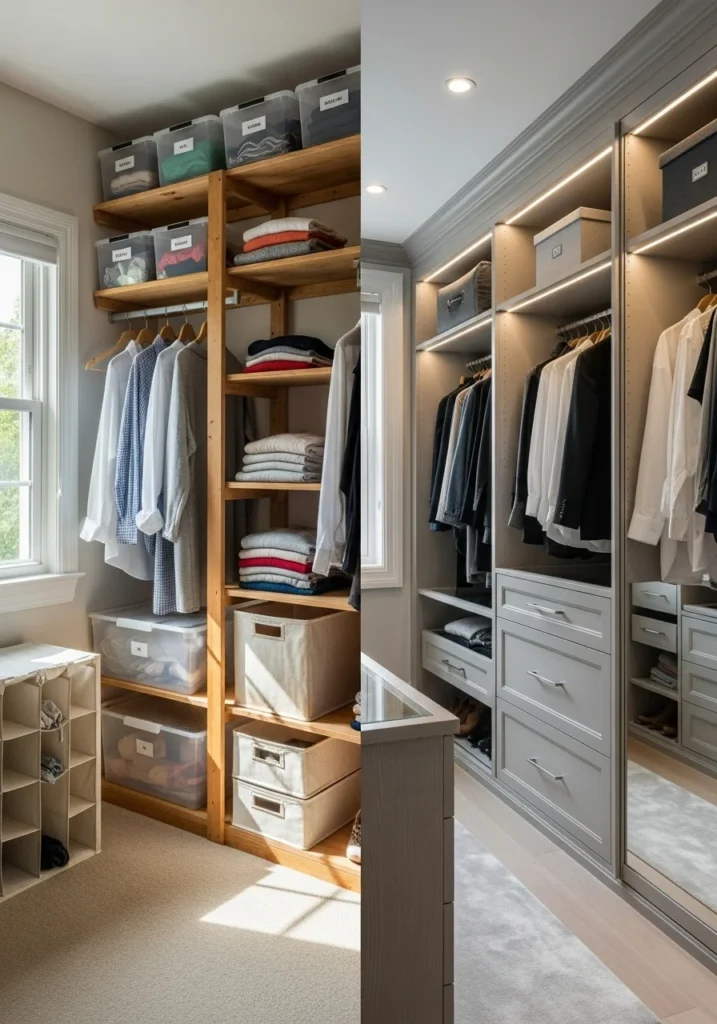
Budget-Friendly Organization Hacks
Organizing your closet doesn’t have to cost a fortune. While luxury closet systems and high-end organizers are attractive, you can achieve an equally functional and stylish result using items you already have or can purchase on a tight budget. With a little creativity and resourcefulness, you can turn everyday objects into clever storage solutions that maximize space and keep your closet neat and tidy.
Here are some genius, budget-friendly closet organization hacks that prove you don’t need to spend big to get organized:
1. Use Old Shoe Boxes as Drawer Dividers
Before you toss out that empty shoe box, consider how it can be repurposed. Shoe boxes and their lids make excellent drawer dividers, helping to keep socks, underwear, belts, and accessories neatly separated.
How to use them:
- Cut the box to fit the height of your drawer.
- Use multiple boxes or lids side-by-side for a grid-style layout.
- Cover them with decorative paper or fabric for a cleaner look.
This no-cost solution instantly brings order to messy drawers without the need for expensive organizers.
2. Repurpose Kitchen Spice Racks for Accessories
A surprising yet effective organization trick is to use wall-mounted spice racks—normally found in kitchens—for storing accessories like perfumes, sunglasses, watches, bracelets, or even folded scarves.
Why it works:
- Spice racks are narrow, making them perfect for closet walls or doors.
- They keep small items visible and easy to grab.
- They add a chic, boutique-like display element to your closet.
You can often find spice racks at thrift stores or discount home goods stores, making this a stylish and budget-friendly upgrade.
3. Use PVC Pipes to Store Boots Upright
Tired of your tall boots slouching over or getting creased in a heap on the closet floor? PVC pipes are a creative and inexpensive fix. Cut them to the height of your boots and insert one into each boot to keep them standing tall and maintaining their shape.
Benefits:
- Prevents sagging and permanent folds in leather or suede boots.
- Keeps your closet floor looking clean and orderly.
- A great way to store boots upright without investing in pricey boot stands.
You can buy PVC piping at any hardware store and cut it to size using a basic saw—or ask a store associate to cut it for you.
4. Use Tension Rods for Extra Hanging or Shoe Space
Tension rods are a budget organizer’s best-kept secret. These adjustable rods are affordable, renter-friendly, and easy to install—no drilling required. You can place them anywhere in your closet to add hanging or stacking space.
Creative uses include:
- Install a rod low to the ground for hanging shoes with S-hooks or clips.
- Add a rod in a narrow space to hang scarves, ties, or belts.
- Use one as a divider inside a deep shelf to organize bags or clothing sections.
They’re especially helpful in small closets where maximizing vertical space is essential.
5. Buy Dollar Store Bins Instead of Name Brands
While high-end storage bins are nice, dollar stores offer just-as-functional options at a fraction of the cost. Look for plastic baskets, fabric boxes, and stackable bins in a variety of sizes and styles.
Smart tips:
- Use bins to group like items together (e.g., winter accessories, workout gear, handbags).
- Label each bin clearly to keep your system easy to maintain.
- Mix and match colors or styles to match your aesthetic—or spray paint for a coordinated look.
Dollar store bins are a great solution for organizing on a tight budget and still achieving a neat, pulled-together closet.
Final Thoughts on Budget Closet Organization
You don’t need a big budget to have a beautifully organized closet. With a little creativity and a do-it-yourself mindset, you can transform your space using low-cost items that offer just as much functionality as expensive alternatives. Whether you’re repurposing household items or discovering hidden gems at your local dollar store, these affordable hacks prove that organization is more about smart thinking than spending.
The key is to think outside the box—and sometimes use the box (literally)! These budget-friendly ideas can make your closet feel more spacious, efficient, and personal—without draining your wallet.
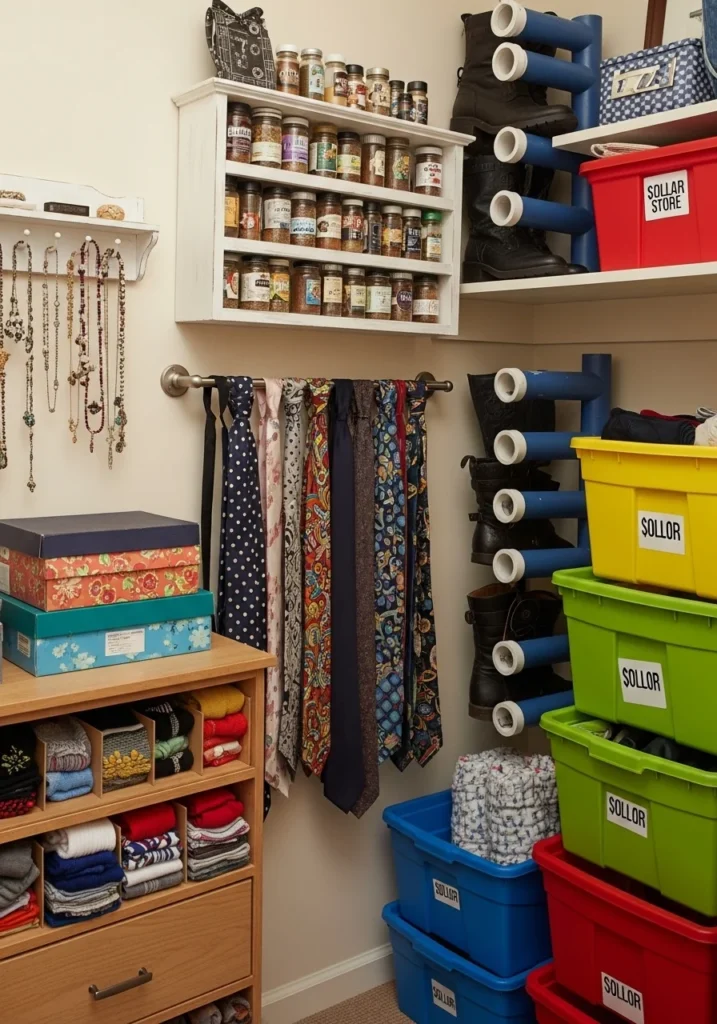
Maintenance & Daily Habits
Getting your closet beautifully organized is a major accomplishment—but keeping it that way is the real game-changer. Without a simple, consistent routine, even the most perfectly arranged closet can quickly fall back into chaos. The good news? Maintaining an organized closet doesn’t require hours of work—it just takes a few smart daily and monthly habits.
By incorporating these practical maintenance tips into your lifestyle, you can enjoy a clutter-free closet all year long with minimal effort. Here’s how to make organization a lasting habit:
1. Follow the “One In, One Out” Rule
Every time you bring something new into your closet—whether it’s a new shirt, dress, or pair of shoes—remove an existing item. This “one in, one out” rule is a simple yet effective way to keep your wardrobe balanced and prevent overcrowding.
Why it works:
- Encourages mindful shopping and reduces impulse buys.
- Helps you constantly edit your closet and keep only what you love.
- Keeps your closet at a manageable, clutter-free size.
Create a small donation bin nearby to make it easier to discard items as you bring in new ones.
2. Spend Just 5 Minutes Each Night
At the end of the day, dedicate five quick minutes to tidying your closet. Rehang clothes, fold anything you tossed aside, and return shoes or accessories to their designated spots. Doing this daily prevents clutter from accumulating and saves you from spending hours reorganizing later.
Evening closet maintenance can include:
- Hanging up jackets or clothes you tried but didn’t wear.
- Folding laundry and putting it away immediately.
- Placing shoes back in their rack or bin.
- Straightening shelves or drawers that got messy during the day.
This habit turns a once-daunting task into a manageable part of your evening routine.
3. Do a Quick Closet Check Monthly
Once a month, take 10–15 minutes to scan your closet and do a light reset. Look for cluttered zones, misplaced items, or clothing that doesn’t belong. A monthly mini-cleanse helps you spot problem areas early and maintain the structure you worked hard to create.
What to check:
- Are your bins and shelves still categorized correctly?
- Are there clothes that no longer fit or that you don’t wear?
- Has anything fallen out of place or become disorganized?
- Are your daily essentials still easy to reach?
This is also a good time to dust shelves, vacuum the closet floor, or freshen up with a new scented sachet or drawer liner.
4. Reassess Your Storage System Every Season
Every season brings a shift in what you wear and how often you use certain items. At the start of each season (about every three months), evaluate whether your current closet setup still serves your needs.
Ask yourself:
- Do you need to rotate seasonal items in or out?
- Are your drawers overflowing while your hanging space is half-empty?
- Have your habits changed (e.g., working from home more often)?
- Would adding or removing a bin, shelf, or hook make things easier?
You don’t need a full closet makeover every season—but a few thoughtful tweaks can help keep your system fresh and functional.
Final Thoughts on Closet Maintenance
Closet organization isn’t a one-time task—it’s a lifestyle habit. But maintaining an organized closet doesn’t have to feel like a chore. With small, consistent actions like tidying up daily, editing your wardrobe monthly, and reevaluating your system each season, you’ll create a low-maintenance routine that keeps your space in top shape year-round.
Think of your closet like a living system that grows and changes with you. A few minutes of attention each day goes a long way in keeping things neat, functional, and enjoyable. With these habits in place, you’ll never have to “start over” again—just keep building on the smart foundation you’ve created.
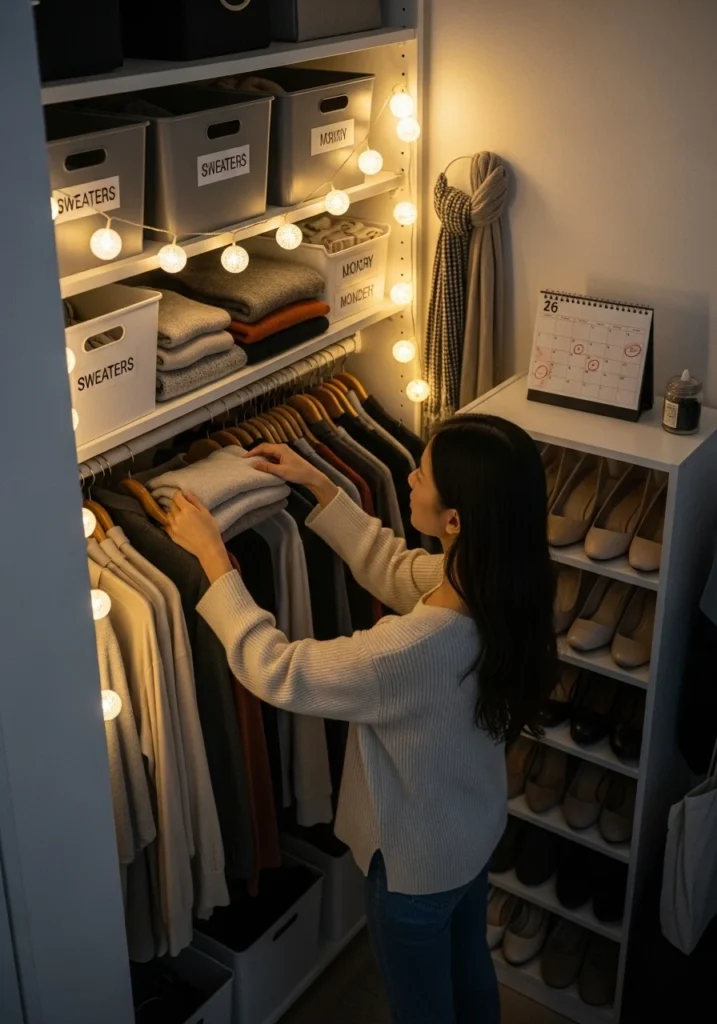
Final Thoughts
Closet organization isn’t just about making your space look Pinterest-perfect—it’s about reclaiming control over your environment and your daily routine. A well-organized closet can reduce stress, save time, and even help you feel more confident and put together. But more than that, it represents a larger shift in how you approach your home and lifestyle.
When your closet is clutter-free and thoughtfully arranged, it becomes a place of inspiration rather than frustration. Instead of digging through piles or feeling overwhelmed by “stuff,” you’ll open your closet each morning and feel a sense of calm, clarity, and readiness to take on the day.
Transforming Your Closet = Transforming Your Mindset
Closet organization is more than just a chore—it’s a mindset. It’s a commitment to simplicity, intentionality, and functionality. When you know exactly where everything is, and when your wardrobe reflects your current style and needs, it becomes easier to make decisions, feel confident in what you wear, and even shop more consciously.
You don’t need a massive space, a big budget, or a full-blown renovation to make this transformation happen. With a few creative ideas, the right tools, and consistent habits, anyone can turn even the smallest or most chaotic closet into a well-oiled system that supports daily life.
Start Small, Stay Consistent
The key to long-term success is starting with small, manageable changes. You don’t have to overhaul your entire closet in one day. Start by:
- Decluttering one section at a time,
- Swapping mismatched hangers for uniform ones,
- Adding a few labeled bins,
- Or installing a simple over-the-door organizer.
Once you’ve built a foundation, consistency is everything. Regular maintenance—whether it’s a 5-minute tidy-up or a seasonal rotation—helps prevent mess from creeping back in and makes it easier to stay organized in the long run.
A Reflection of Your Style and Self-Care
At its best, an organized closet becomes a reflection of your personal style, self-respect, and self-care. It shows that you value your time, your belongings, and your environment. It also makes getting dressed a more enjoyable and intentional part of your routine rather than a rushed, stressful process.
Plus, when your wardrobe is curated and accessible, you tend to wear more of what you own, make better outfit choices, and reduce unnecessary spending.
Final Encouragement
Closet organization may seem like a small project, but its ripple effect is powerful. It can improve your mornings, reduce decision fatigue, and even spark motivation to organize other areas of your home. More importantly, it creates a space that works for you—not against you.
So whether you’re just beginning your organization journey or fine-tuning your existing system, remember:
Start with one drawer, one habit, one goal.
Stay consistent.
Celebrate the progress—not just the perfection.
With a little creativity, care, and commitment, you can create a closet—and a lifestyle—that feels calm, intentional, and uniquely yours.
